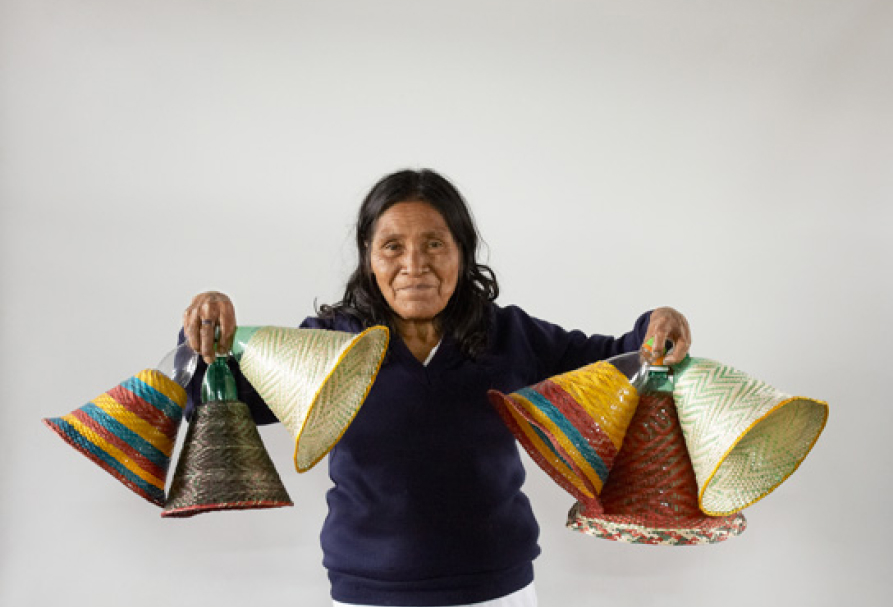Colombia
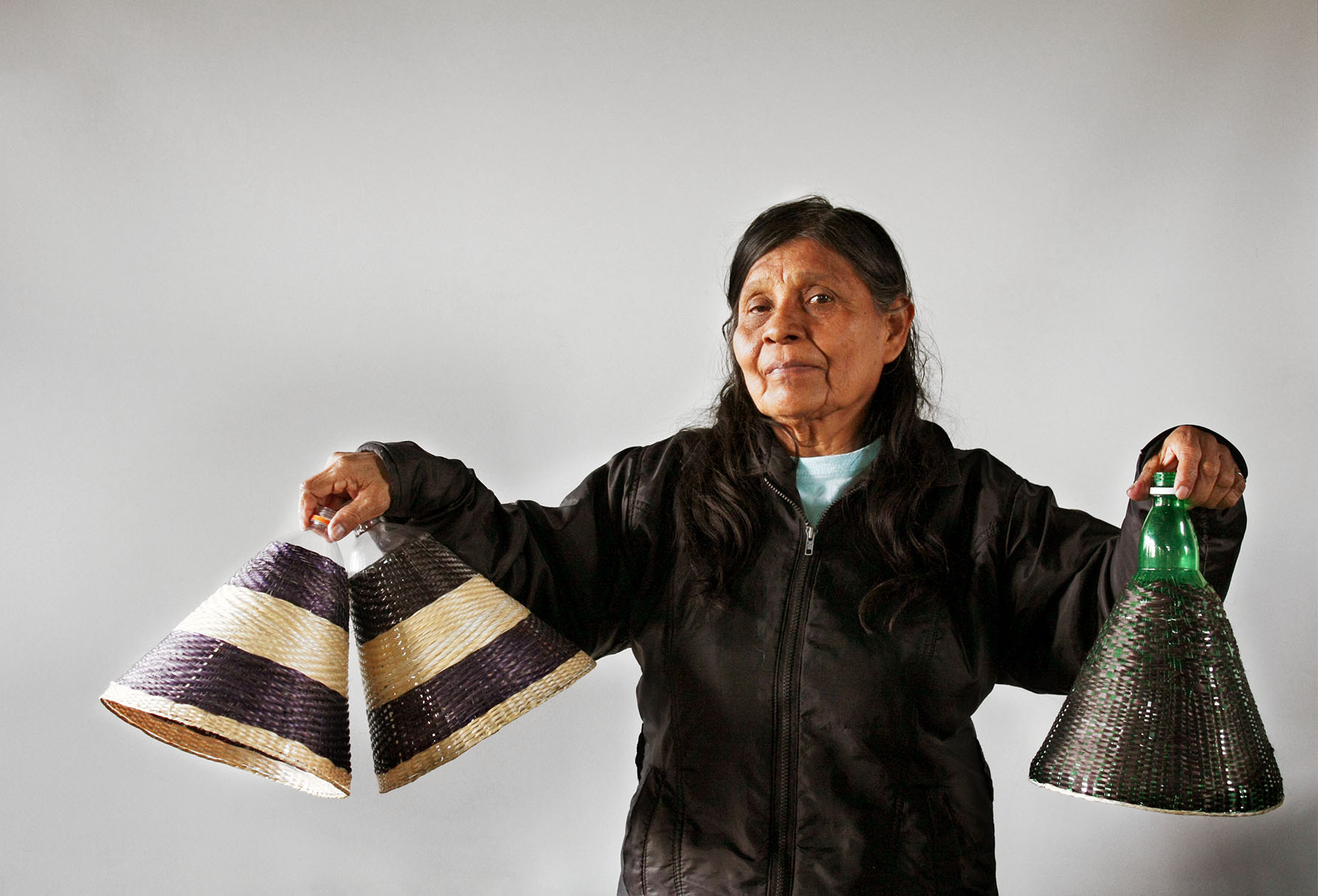
Emerita Chirimio.
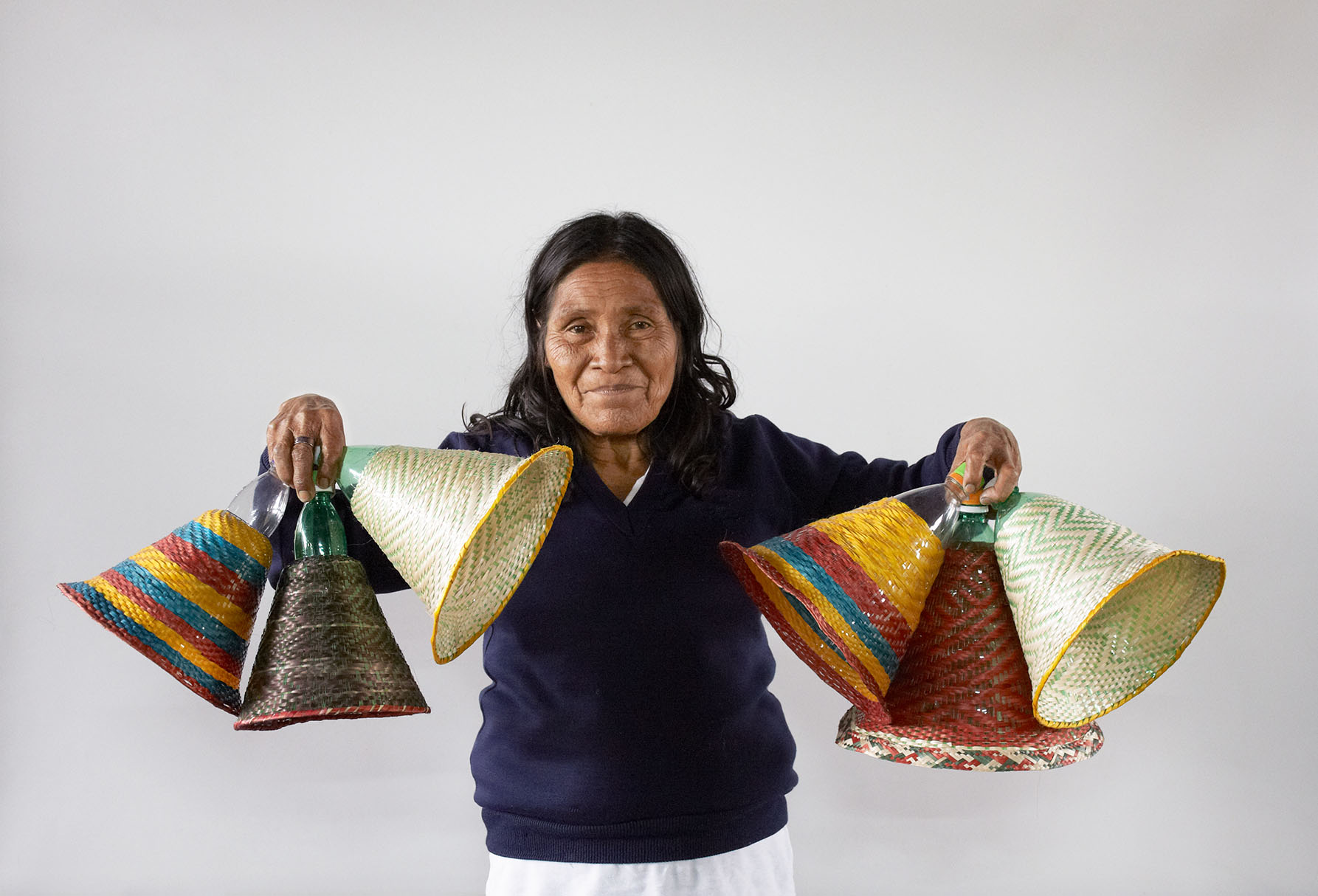
Manuela Dura.
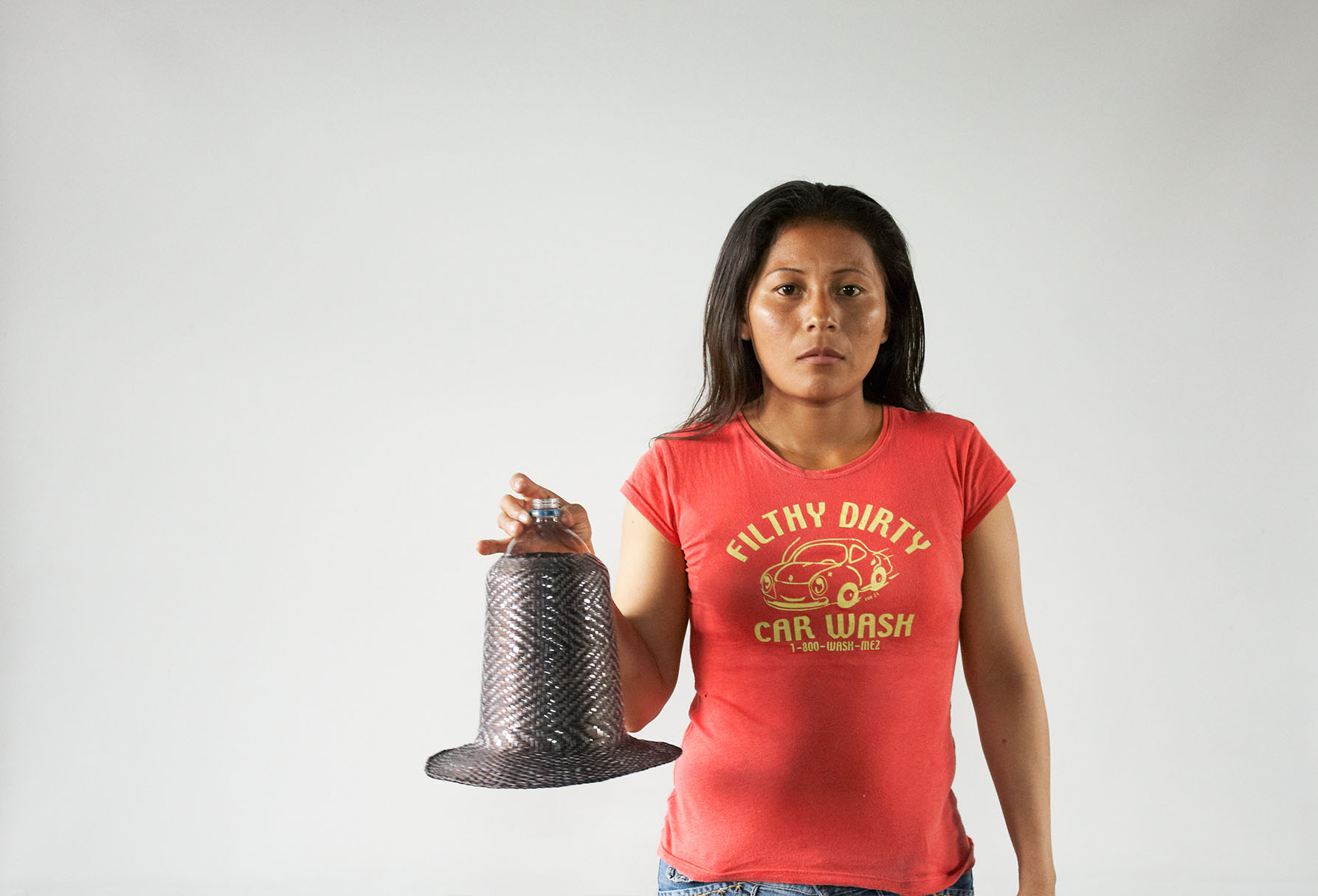
Mélida Valencia.
Colombia
Colombia is a country defined by diversity: Drawing from European colonisation, African influences in the North, and a multitude of indigenous communities, the country’s multiracial population is spread over geography ranging from the lush rainforests of the Amazon up to the frozen heights of the Andes.
In 2012, the PET Lamp Team travelled to Colombia to embark on the very first PET Lamp Project. With the assistance of Artesanías de Colombia, we collaborated with two distinct indigenous communities; The Eperara-Siapidara, and Guambianos who despite hailing from the Cauca region, struggle with poverty in Bogota having been displaced by conflict.
Product produced
In 2013, the PET Lamp Team set its sights on Chimbarongo. Located 150km South of Santiago, the rich soil and dry climate of the region has made it particularly well suited to the cultivation of wicker that was introduced to Chile by Spanish Colonists. Chimbarongo is now recognised as the wicker capital of the country, and our resulting collection reflects the austere beauty of this strong and simple material.
We returned to Chile in 2016, this time to collaborate with the Mapuche women of Huentelolen in the Araucania Region. These women pass from one generation to the next a 500 year old weaving tradition that makes use of Ñocha, a plant that thrives in the well irrigated soil. The knowledge and skill they have built up over the centuries ensured a grand, striking collection that proved that the PET Lamp Project could succeed, even in a region notorious for conflict.
Chile
Product produced
Chile
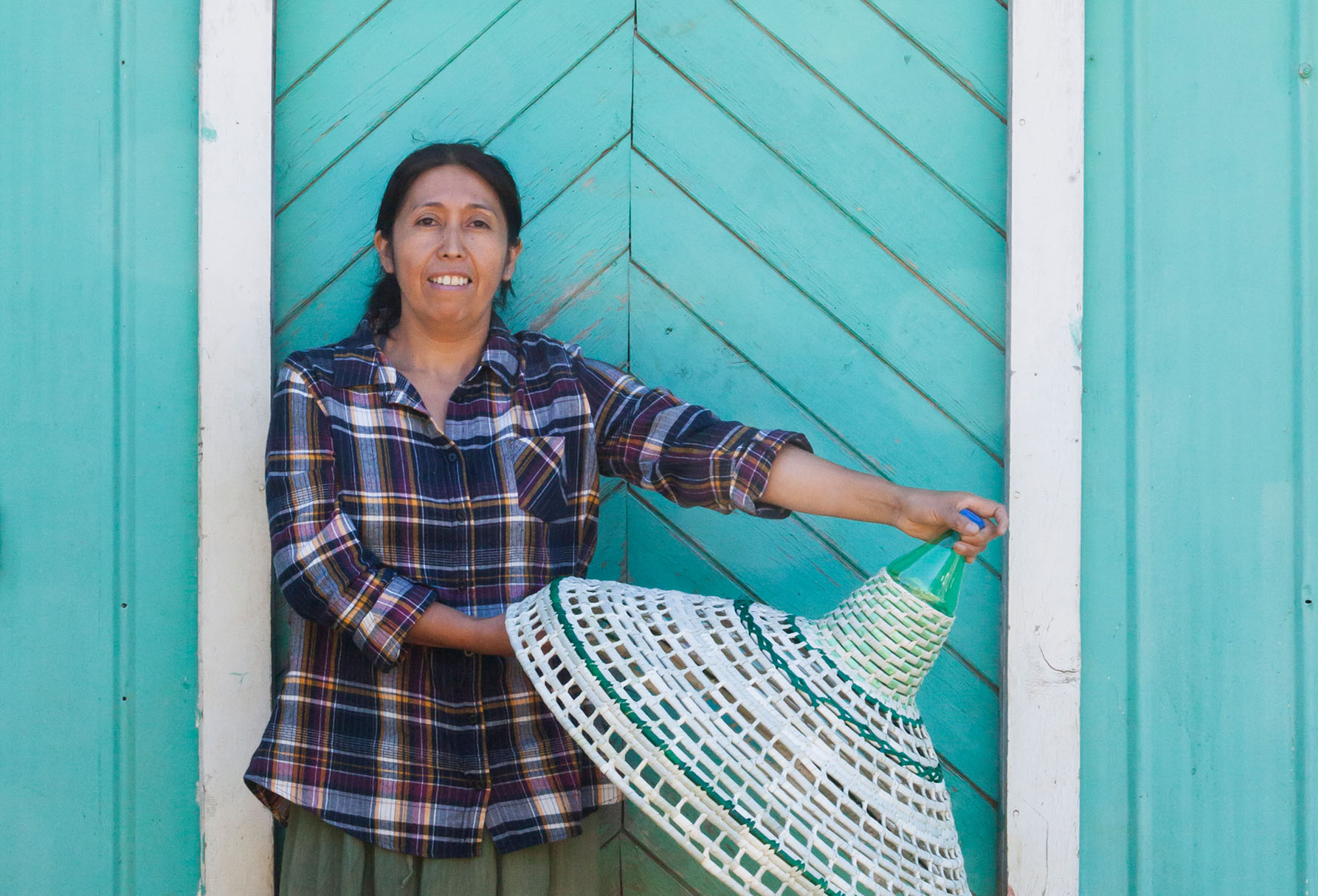
Delia Maliqueo.
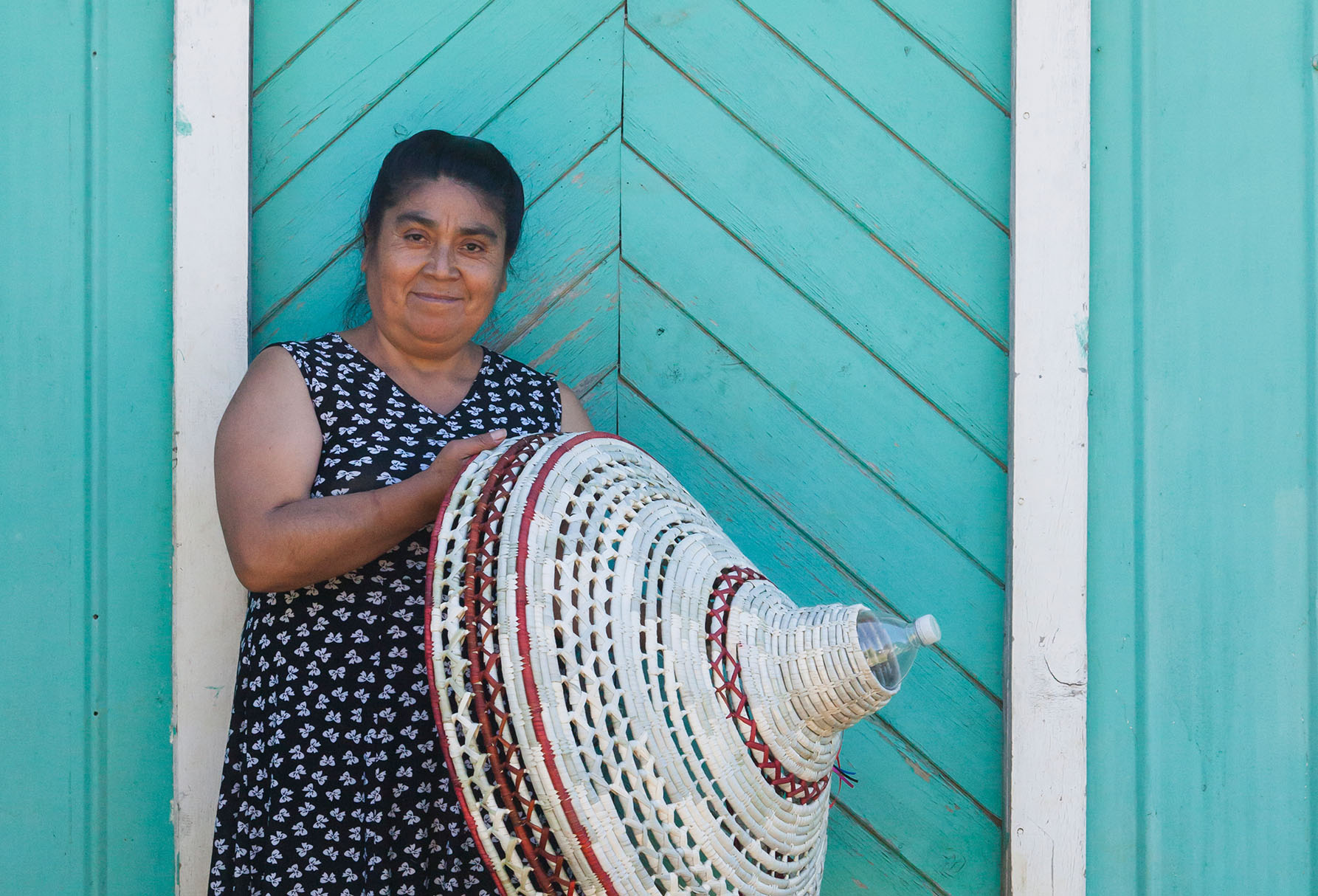
Juana Maribur.
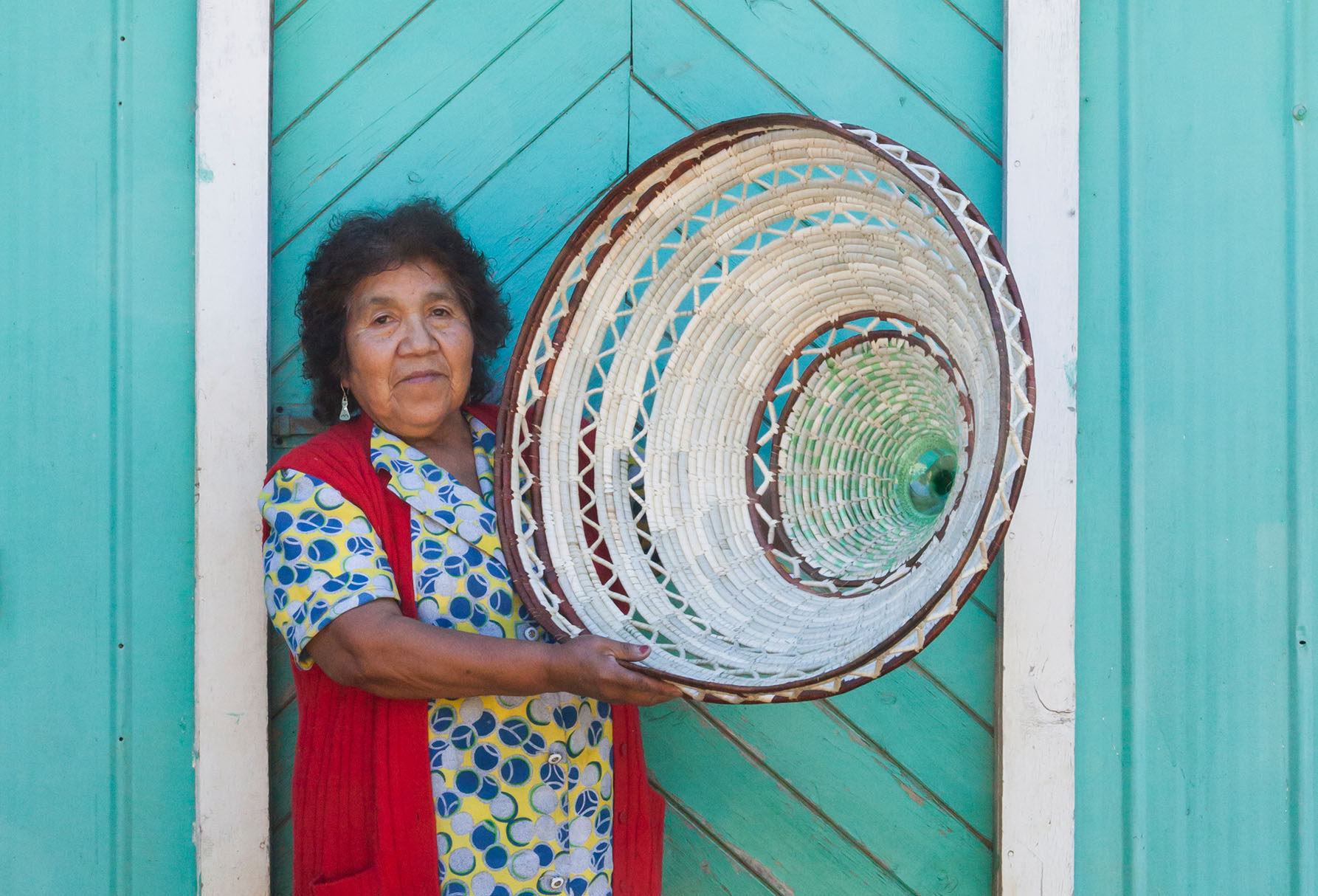
María Inés Aniñir.
Chile
In 2013, the PET Lamp Team set its sights on Chimbarongo. Located 150km South of Santiago, the rich soil and dry climate of the region has made it particularly well suited to the cultivation of wicker that was introduced to Chile by Spanish Colonists. Chimbarongo is now recognised as the wicker capital of the country, and our resulting collection reflects the austere beauty of this strong and simple material.
We returned to Chile in 2016, this time to collaborate with the Mapuche women of Huentelolen in the Araucania Region. These women pass from one generation to the next a 500 year old weaving tradition that makes use of Ñocha, a plant that thrives in the well irrigated soil. The knowledge and skill they have built up over the centuries ensured a grand, striking collection that proved that the PET Lamp Project could succeed, even in a region notorious for conflict.
Product produced
Lorem ipsum dolor sit amet, consectetuer adipiscing elit, sed diam nonummy.
Ethiopia
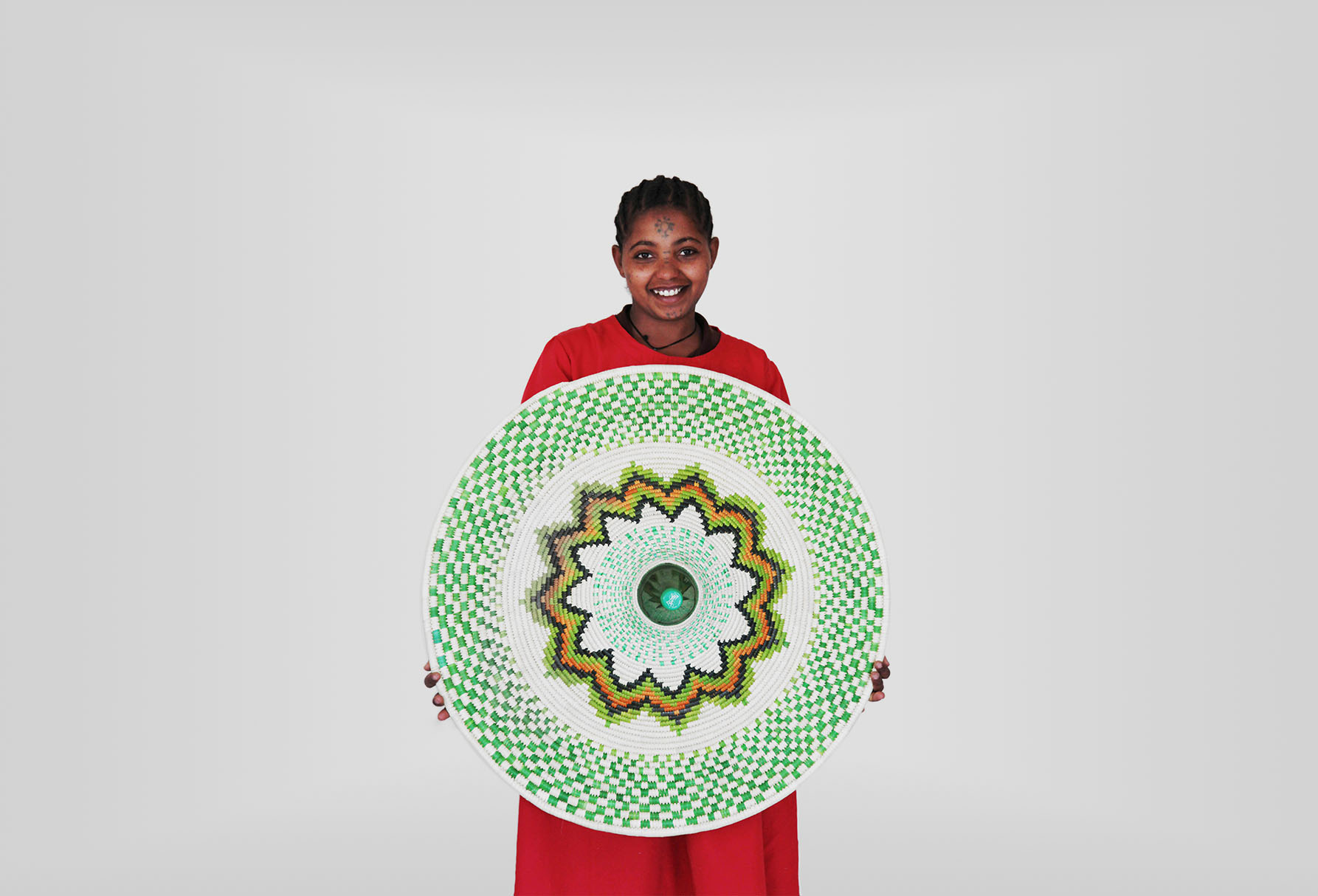
Kasech Demeke.
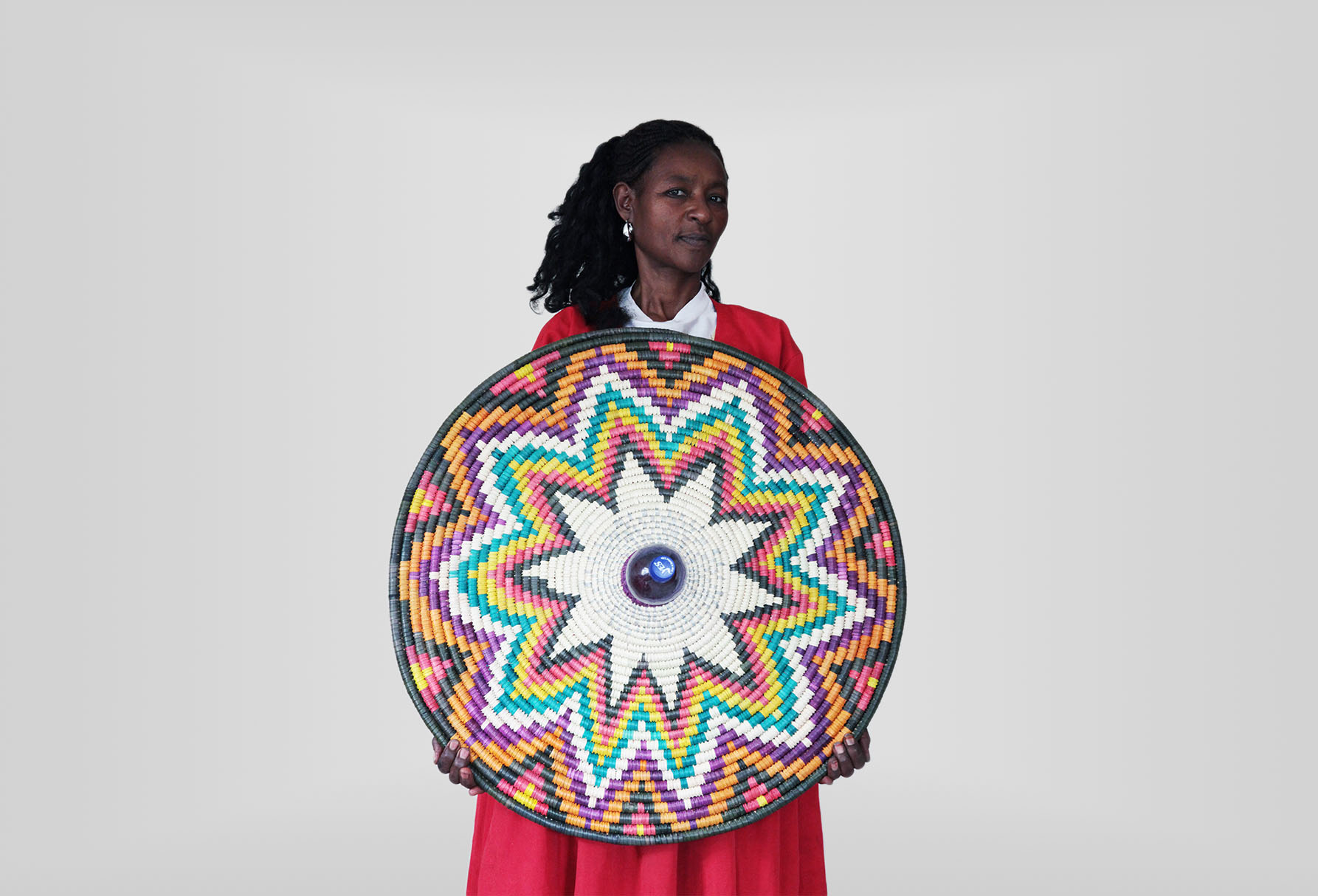
Kenenye Lemma.
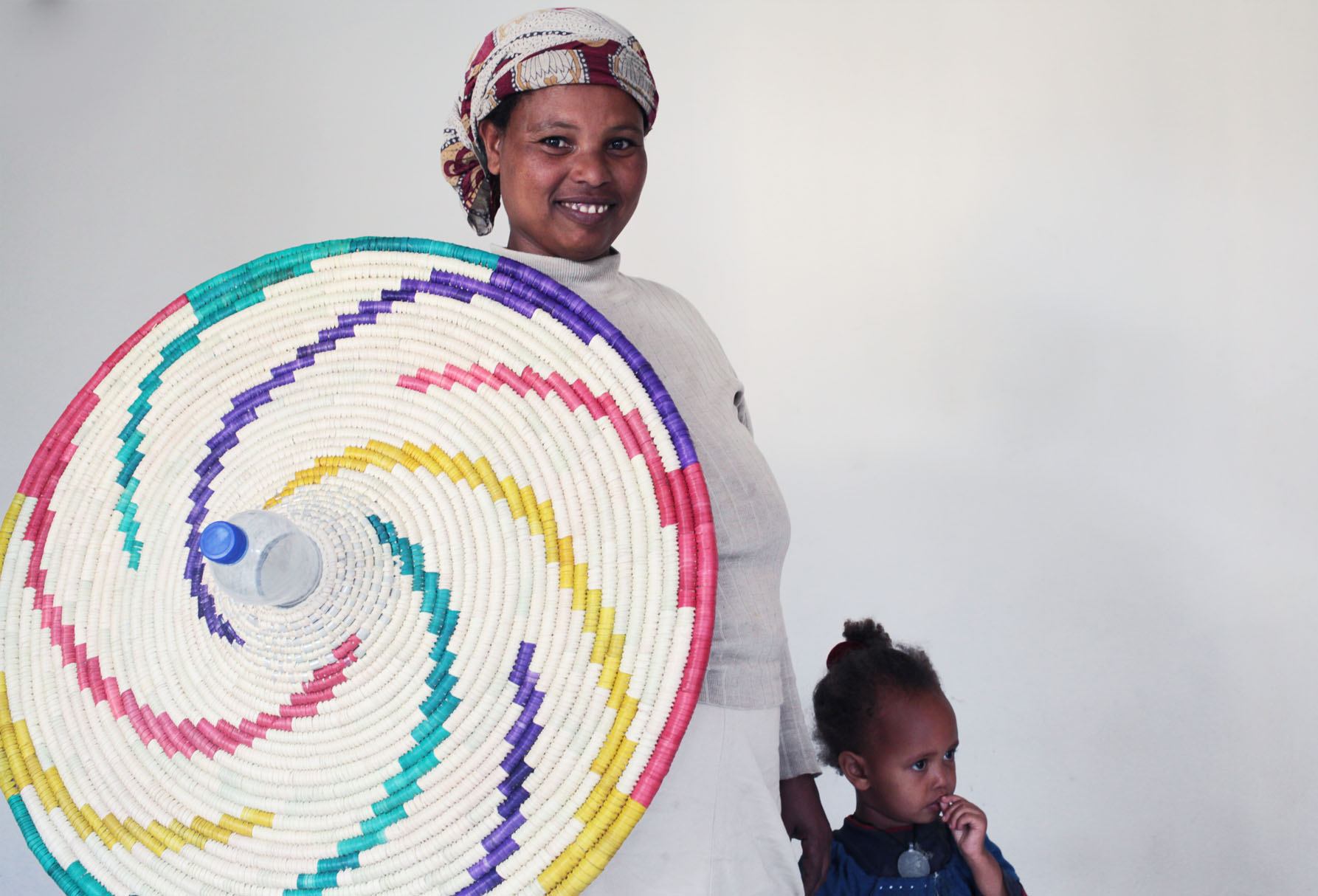
Banchyayhu Mulualem with her daughter Mahilet.
Ethiopia
Ethiopia possesses the most UNESCO World Heritage sites in Africa, and is a truly ancient land with many fascinating cultural, religious and architectural notes. The colourful baskets of Ethiopia are no exception and are regarded as functional, decorative and sacred elements throughout the country.
In Addis Abeba, Salem Kasshun has positioned her shop to specialise in basketwork. By gathering her own group of highly skilled weavers she has been able to achieve a greater flexibility and capacity for experimentation, making Salem’s Ethiopia the perfect collaborator for the PET Lamp Project.
Product produced
Japan, in Asia’s far east, first encountered Buddhism in the late 6th century, which was introduced from China after spreading from India. Many Chinese and Korean craft techniques and inventions followed. Japan’s openness to other civilizations eventually came to an end, when, from the 17th to the mid-19th centuries, Japan cloistered itself from the outside world. This policy was so isolating that Japanese society developed in unique and often magnificent ways.
Eventually, bamboo became an essential material in tea ceremony culture as it developed during the 16th century, when every tool used in a ceremony, including the décor set around the room, was considered to convey important and holistic expressions of aesthetics, values and hospitality.
In the ancient capital of Kyoto, where many of Japan’s most elaborate fine crafts were established, highly delicate bamboo craftsmanship became one of the city’s signature industries, and master artisans passed their skills and titles—along with their pride—to successive generations.
Japan
Product produced
Japan
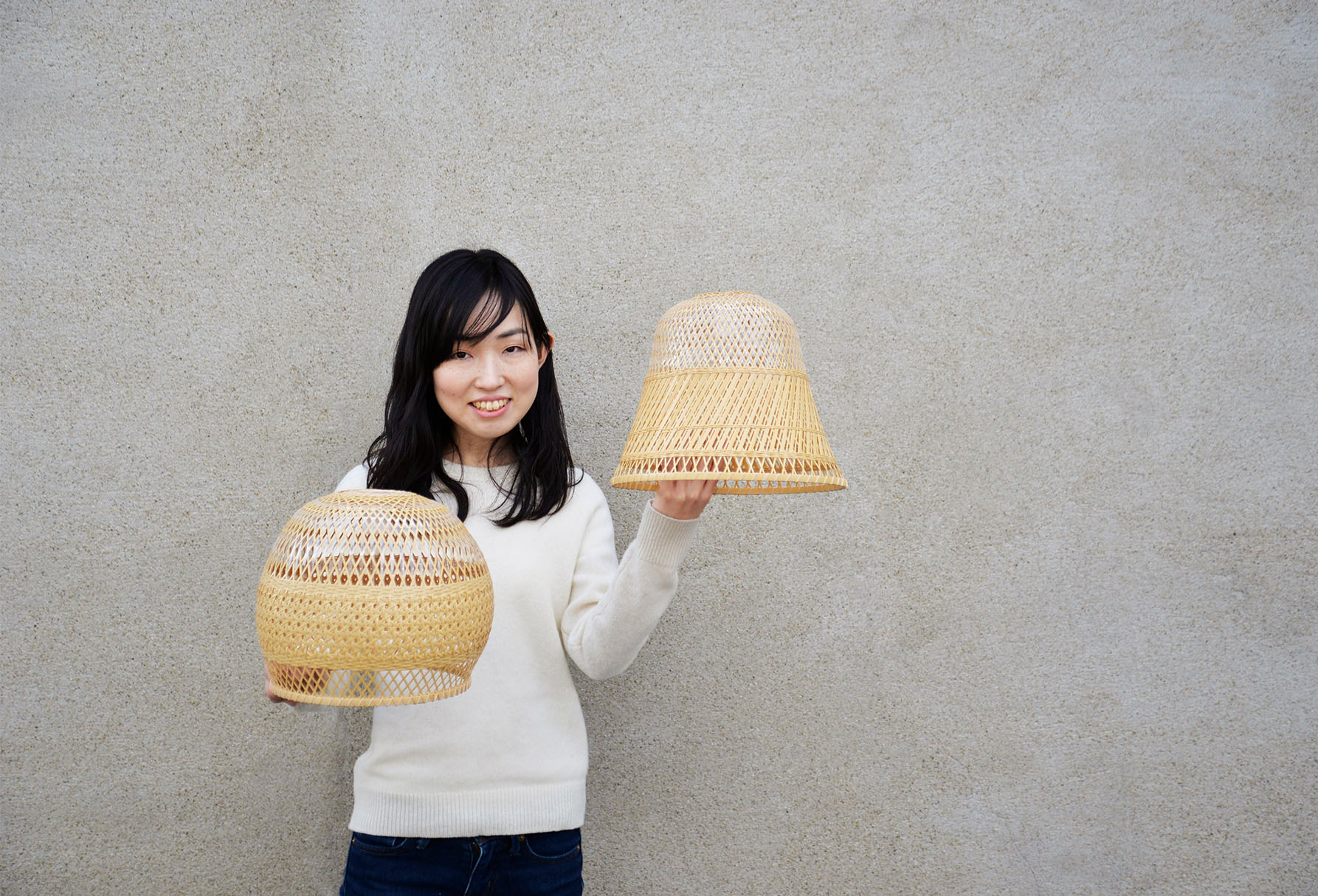
Chiemi Ogura.
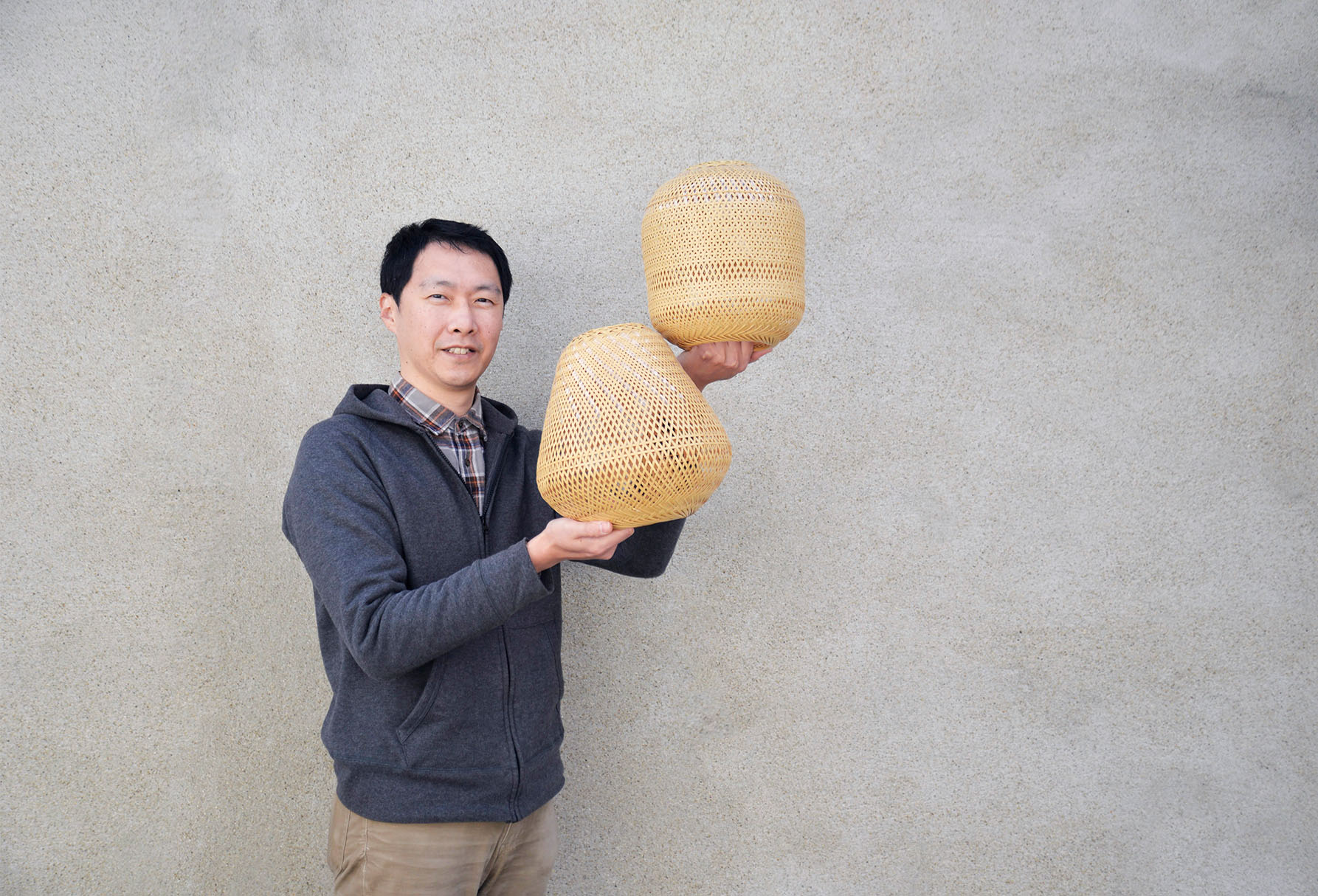
Hideaki Hosokawa.
Japan
Japan, in Asia’s far east, first encountered Buddhism in the late 6th century, which was introduced from China after spreading from India. Many Chinese and Korean craft techniques and inventions followed. Japan’s openness to other civilizations eventually came to an end, when, from the 17th to the mid-19th centuries, Japan cloistered itself from the outside world. This policy was so isolating that Japanese society developed in unique and often magnificent ways.
Eventually, bamboo became an essential material in tea ceremony culture as it developed during the 16th century, when every tool used in a ceremony, including the décor set around the room, was considered to convey important and holistic expressions of aesthetics, values and hospitality.
In the ancient capital of Kyoto, where many of Japan’s most elaborate fine crafts were established, highly delicate bamboo craftsmanship became one of the city’s signature industries, and master artisans passed their skills and titles—along with their pride—to successive generations.
Product produced
Lorem ipsum dolor sit amet, consectetuer adipiscing elit, sed diam nonummy.
Australia
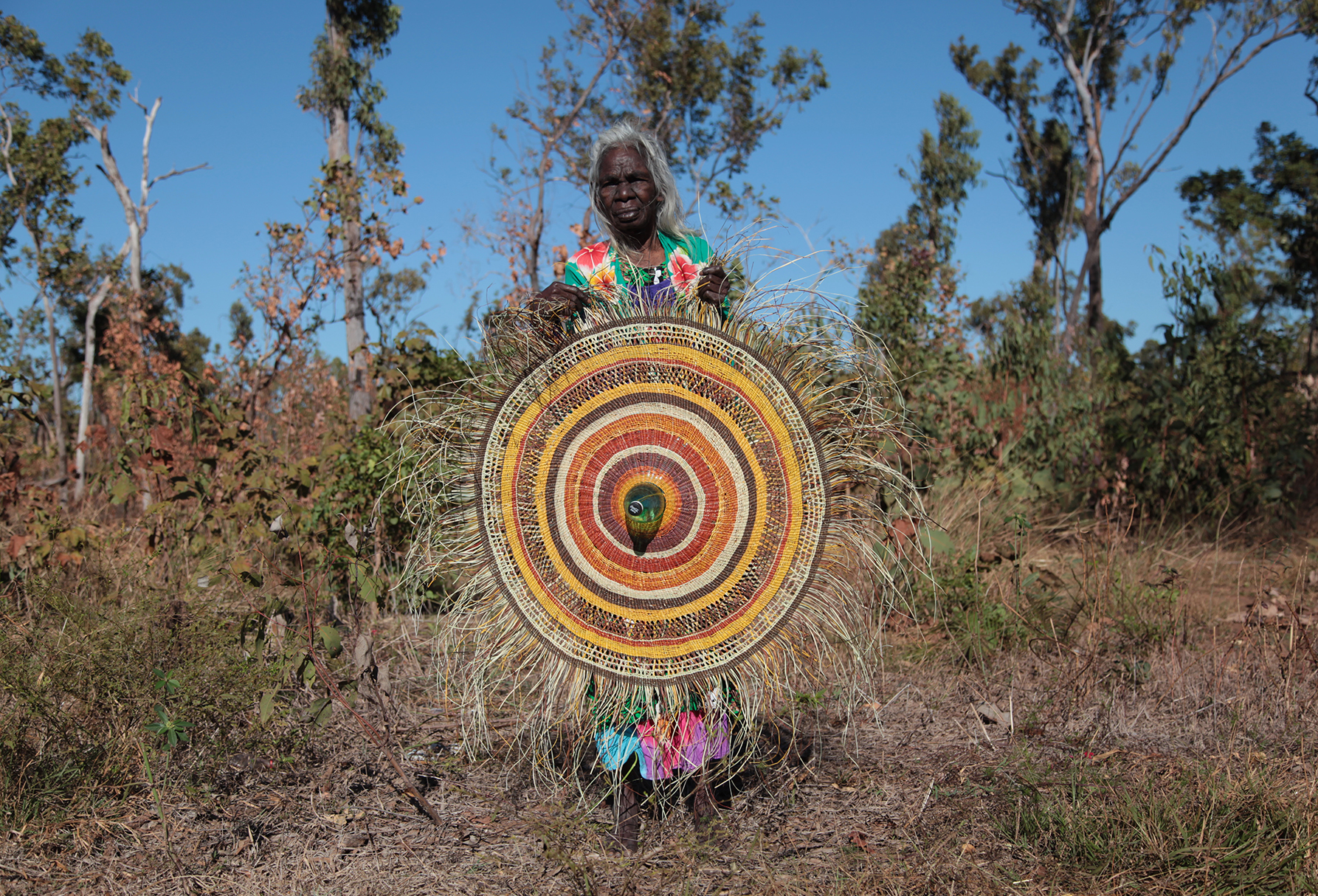
DJILIRR LILIPIYANA, Judith.
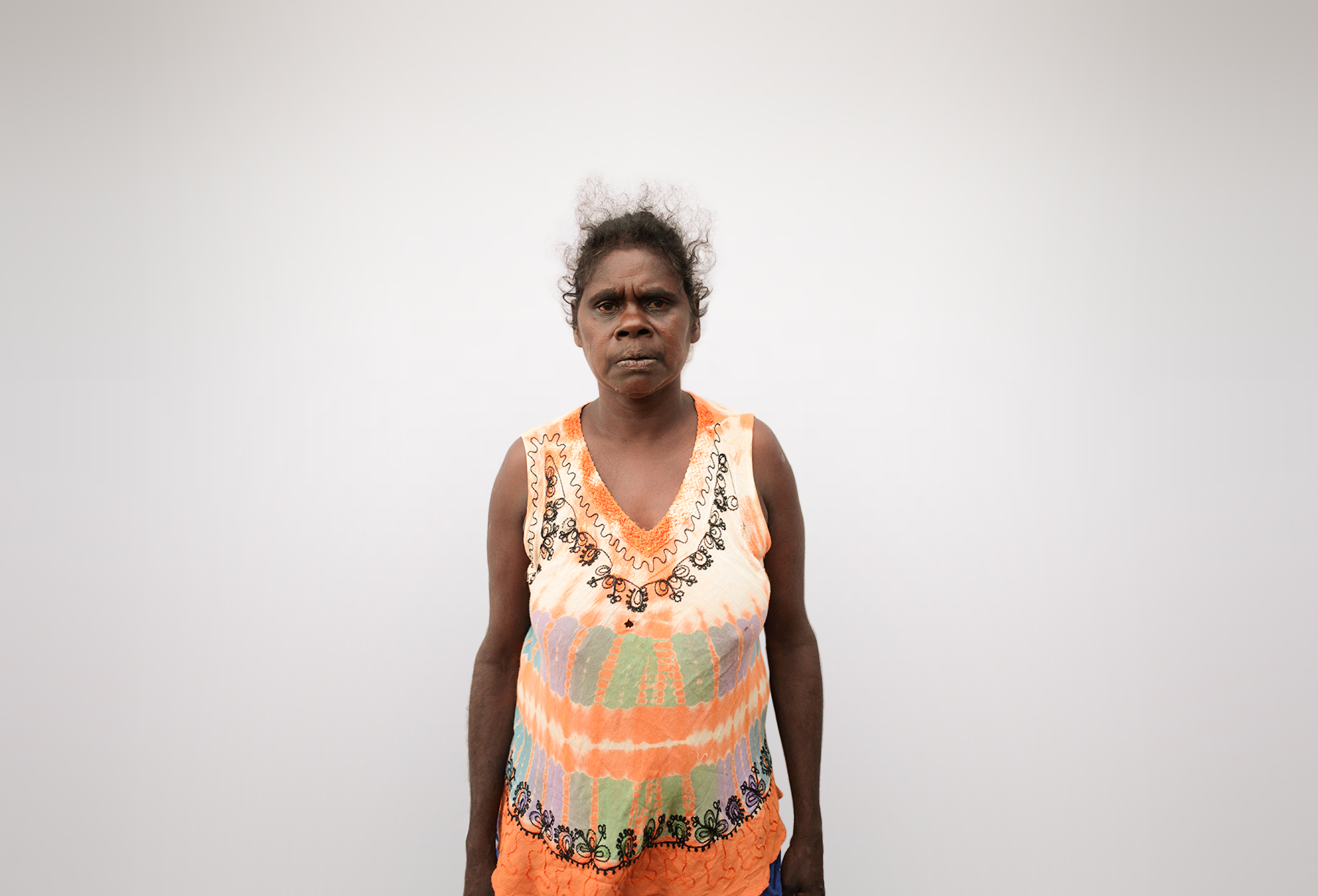
GEDJIN LILIPIYANA, Melinda.
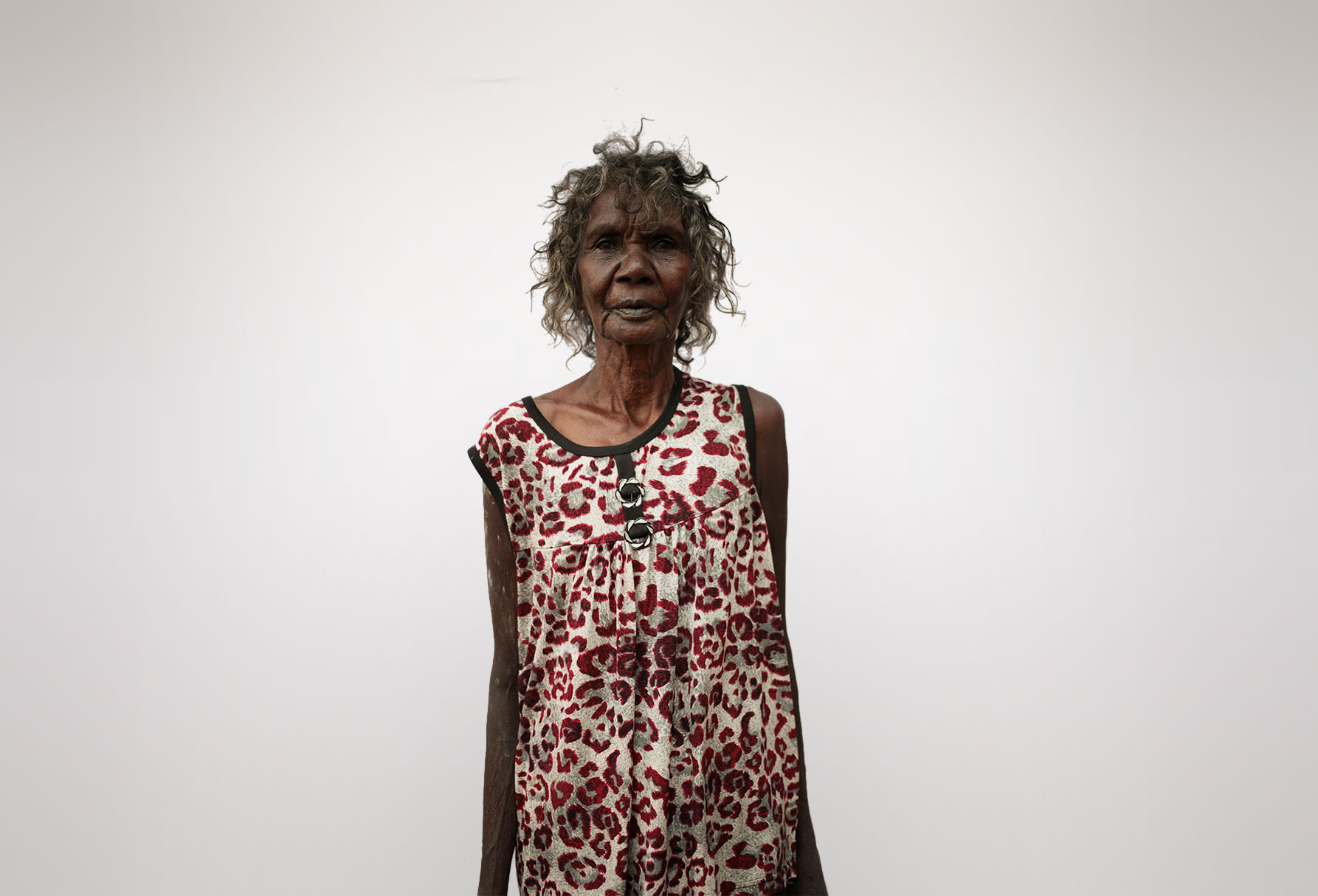
DHAPALANY MANDHALPUYNU, Mary.
Australia
For almost 65,000 years, the Aboriginal population of Australia lived in complete isolation and conserved a unique culture and ecosystem.
Upon arrival of the Europeans at the end of the 18th century, the Aboriginal community was made up of a number of tribes that shared a worldview where the physical (the earth), the human and the sacred were totally integrated.
The Aboriginal vision was not taken into consideration by the colonists, where the European perspective predominated: exploitation of natural resources, accumulation by status, in which human superiority (European) overrode other considerations to create a society that was highly individualistic.
These fundamental differences led to a gap between Aboriginal and non- Aboriginal communities, leaving us with the task of discovering, accepting, transmitting and programming the knowledge of local peoples. In the search for this wealth, and to enable it to be valued by many more, we have sought communities where the traditions and worldview are conserved in their purest form. We had the opportunity to work together to take these paintings and give them back their living form as textiles.
Product produced
The character of Thai basketry tradition comes from the artisan’s calmness which is reflected through extremely precise and balanced pieces. Bamboo is the chosen material – typical of the Southeast Asia region– worked with precision and careful detail by the best craftsmen of the country.
As in previous occasions –through a methodology based on field research, prototyping and on-site workshops– PET Lamp has developed a collection of lampshades in collaboration with the Traditional Bamboo Handicraft Center, a foundation supported by her Majesty Queen Sirikit that enjoys a distinct reputation in the field of handicrafts in the country.
PET Lamp Pikul takes its name after the Mimusops Elengi’s flower. Also known as Spanish Cherry tree, it is a tropical tree found in the forests of this region of Asia. The flower grows in a geometric pattern inspiring the traditional Pikul pattern which can be found in many of the crafts around Thailand.
This material requires the skill and mastery of three craftsmen, each one specialized in one of the techniques of the manufacturing processes required to make each lamp.
Thailand
Product produced
Thailand
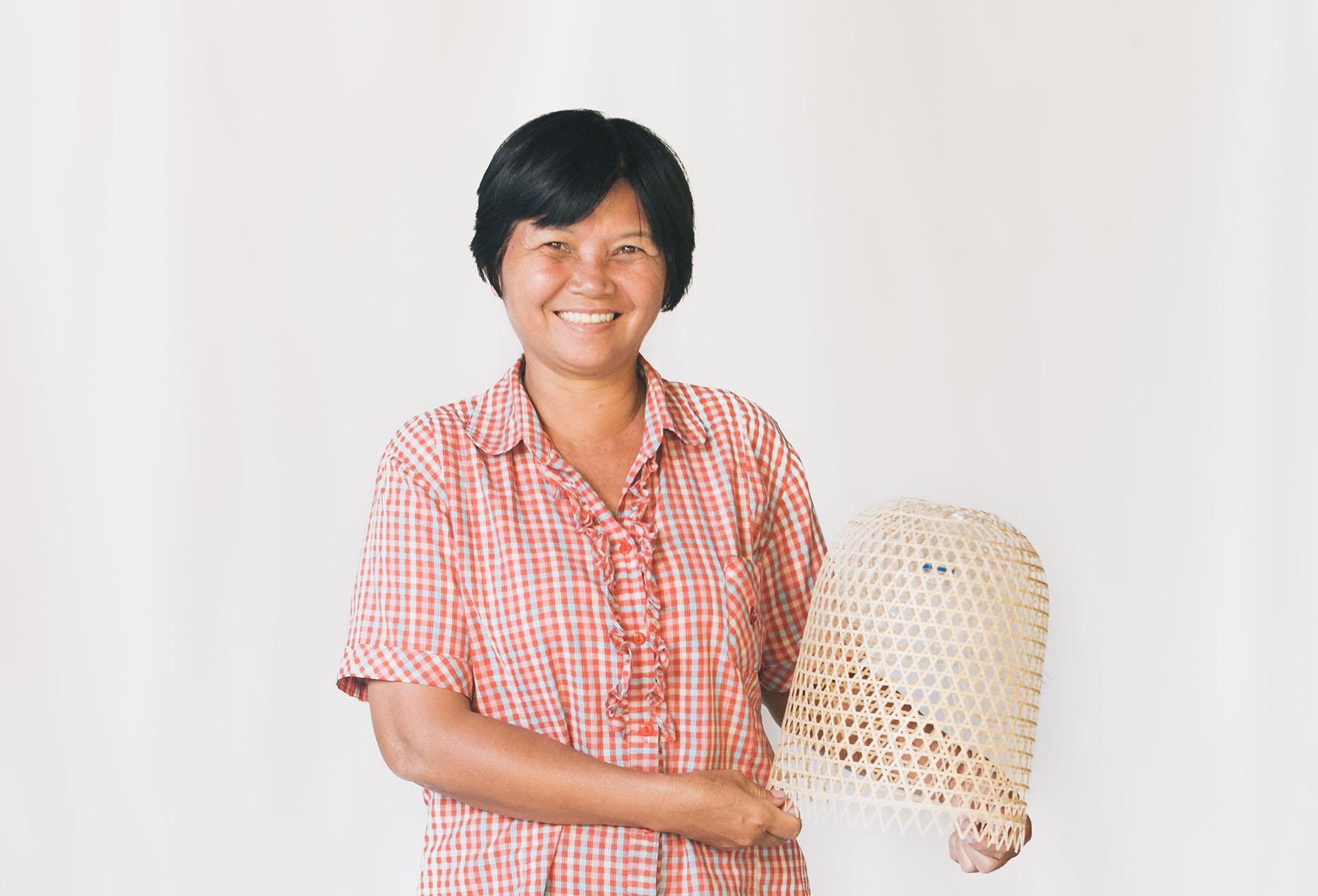
Kannika Chalong.
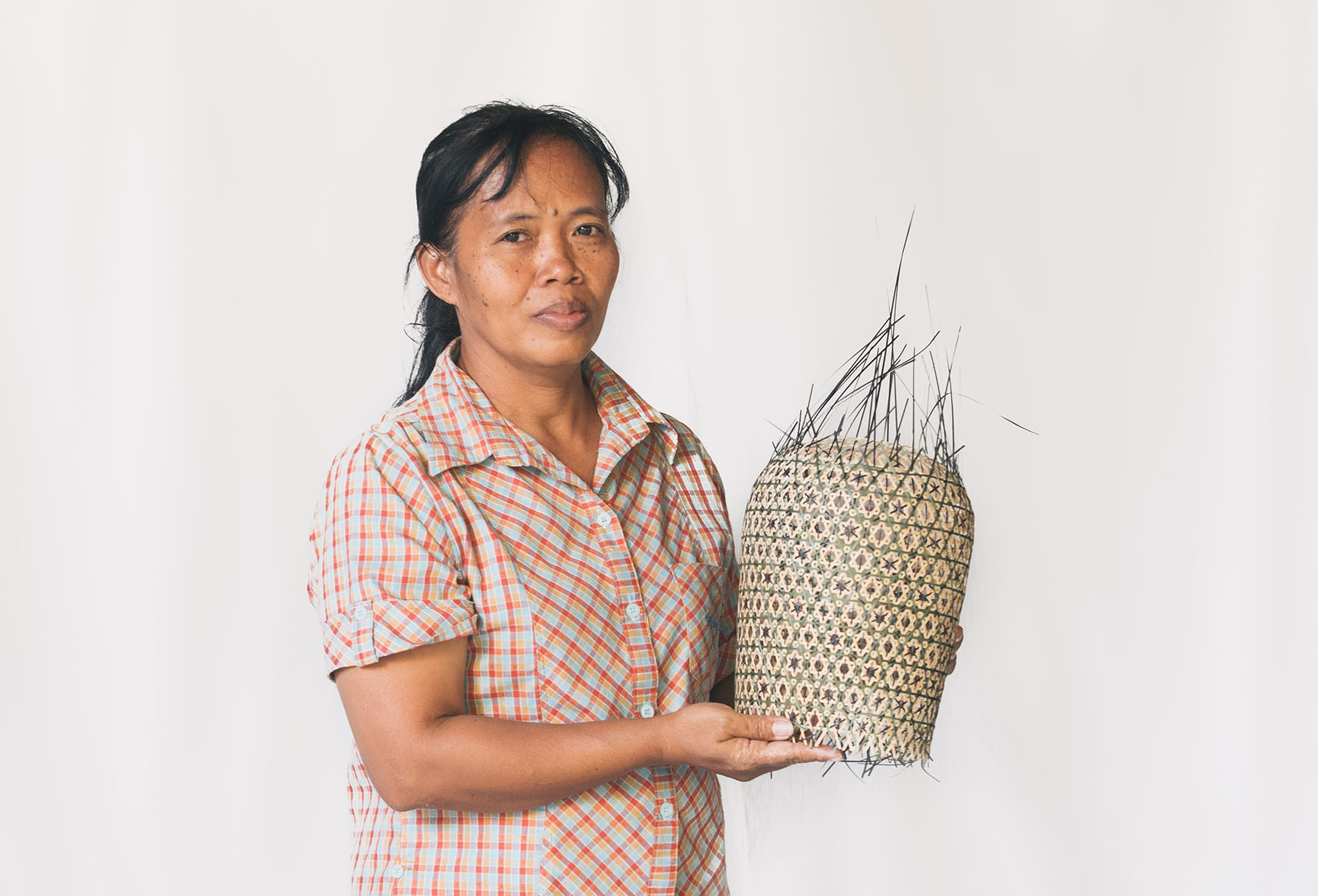
Phayom Arruno.
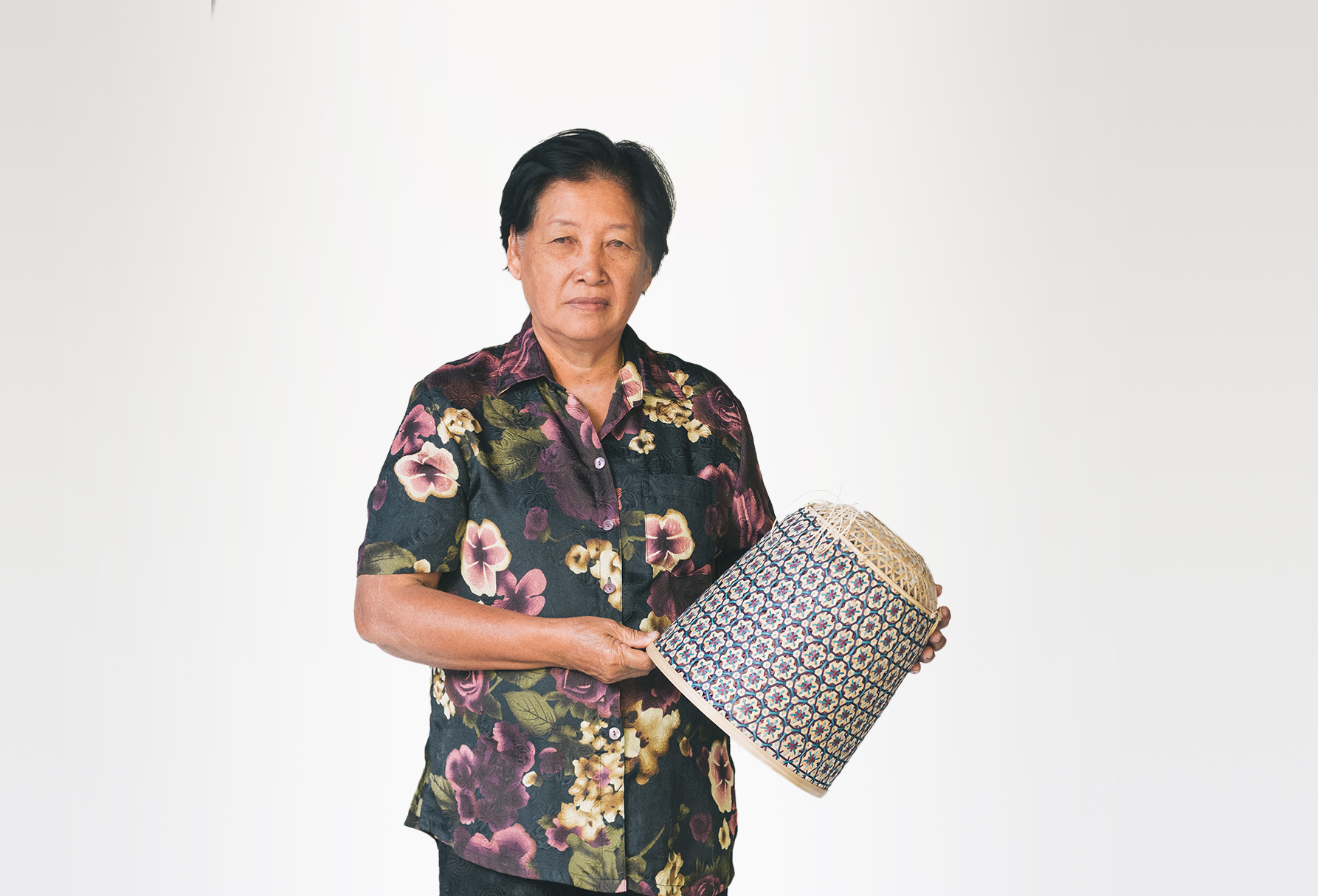
Aumporn Somboonsatcha.
Thailand
The character of Thai basketry tradition comes from the artisan’s calmness which is reflected through extremely precise and balanced pieces. Bamboo is the chosen material – typical of the Southeast Asia region– worked with precision and careful detail by the best craftsmen of the country.
As in previous occasions –through a methodology based on field research, prototyping and on-site workshops– PET Lamp has developed a collection of lampshades in collaboration with the Traditional Bamboo Handicraft Center, a foundation supported by her Majesty Queen Sirikit that enjoys a distinct reputation in the field of handicrafts in the country.
PET Lamp Pikul takes its name after the Mimusops Elengi’s flower. Also known as Spanish Cherry tree, it is a tropical tree found in the forests of this region of Asia. The flower grows in a geometric pattern inspiring the traditional Pikul pattern which can be found in many of the crafts around Thailand.
This material requires the skill and mastery of three craftsmen, each one specialized in one of the techniques of the manufacturing processes required to make each lamp.
Product produced
Ghana
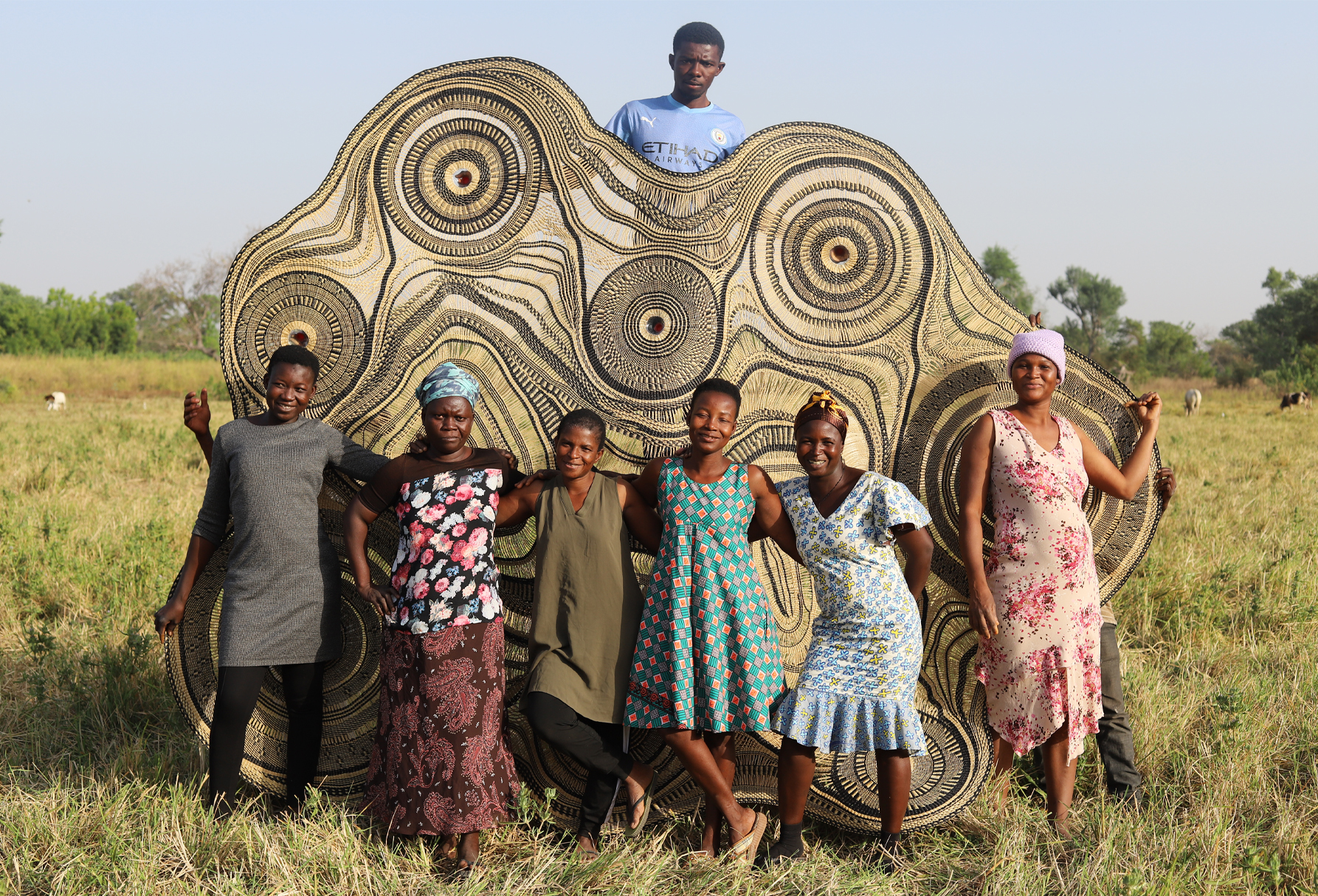
Weavers of Baba Tree Basket Company.
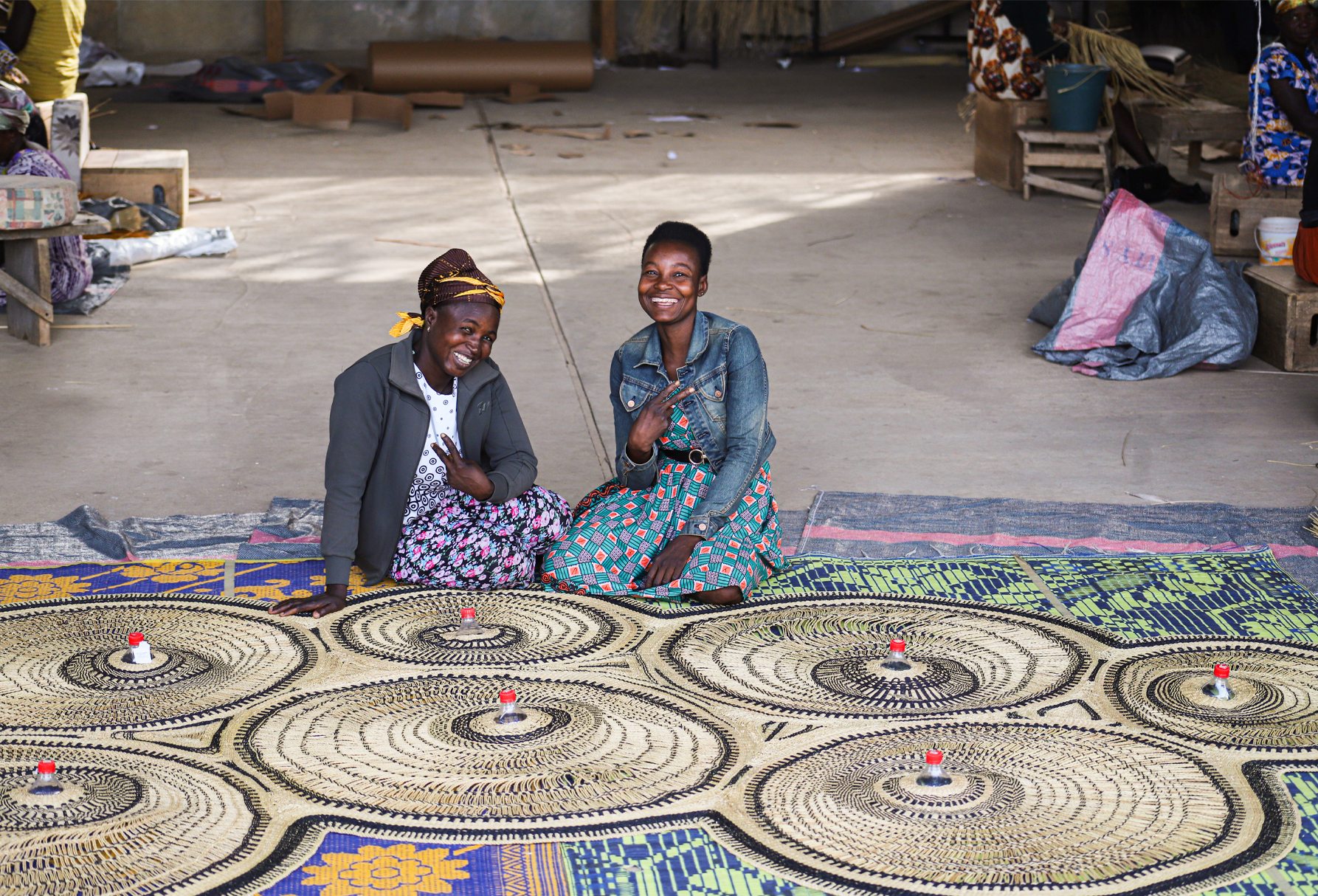
PET Lamp Gurunsi - Making of.
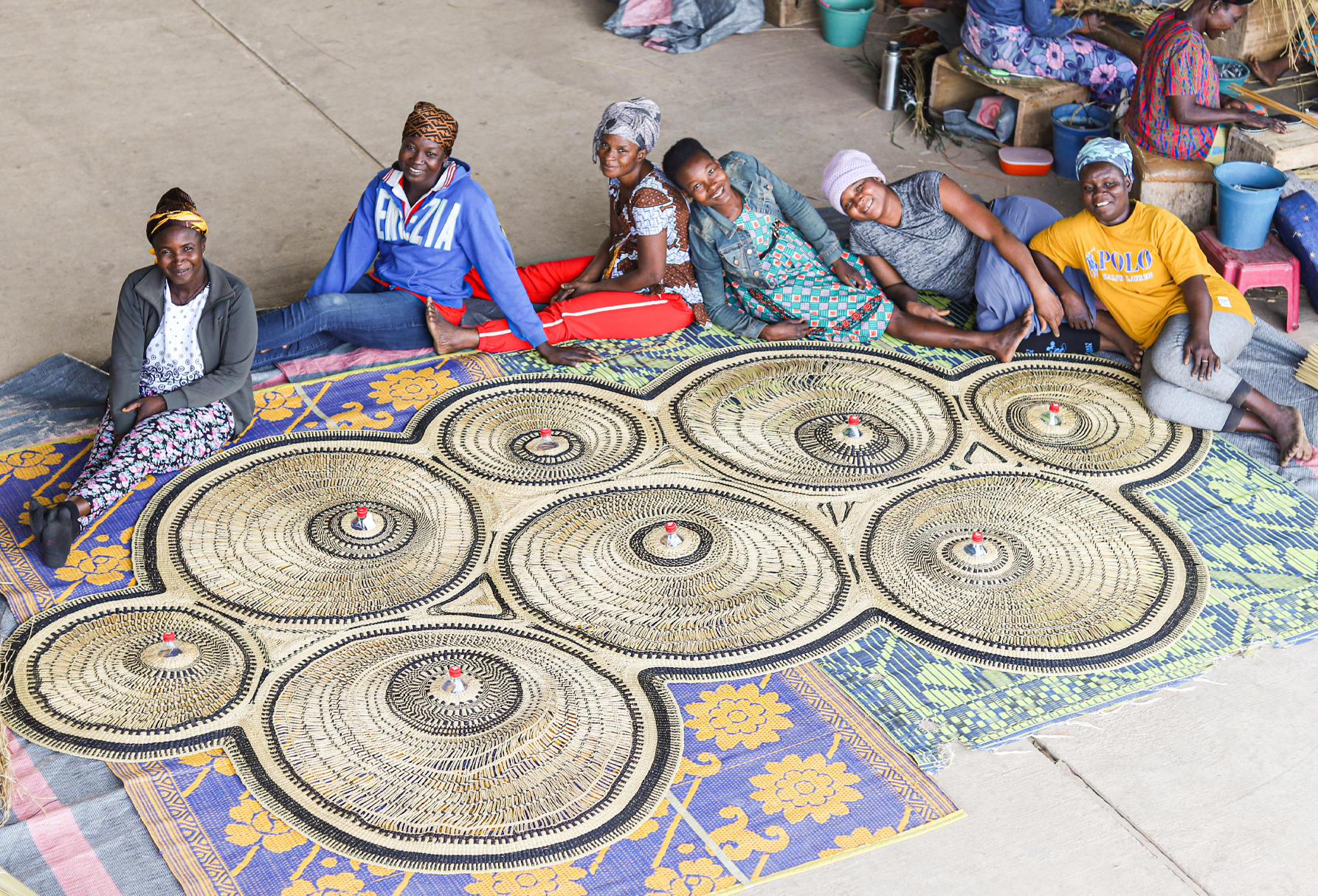
Joy and expertise in one photo.
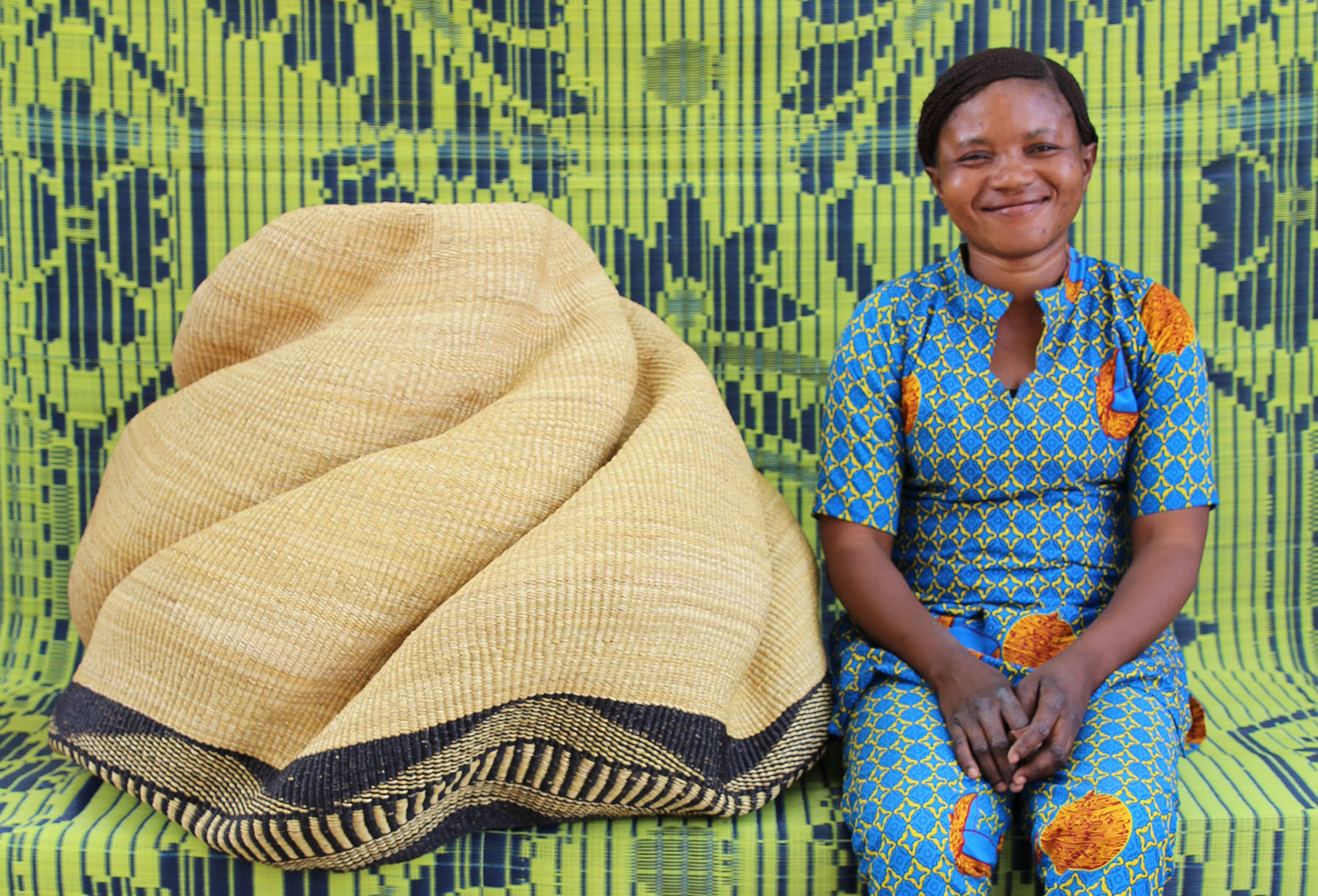
Anamolika Azure.
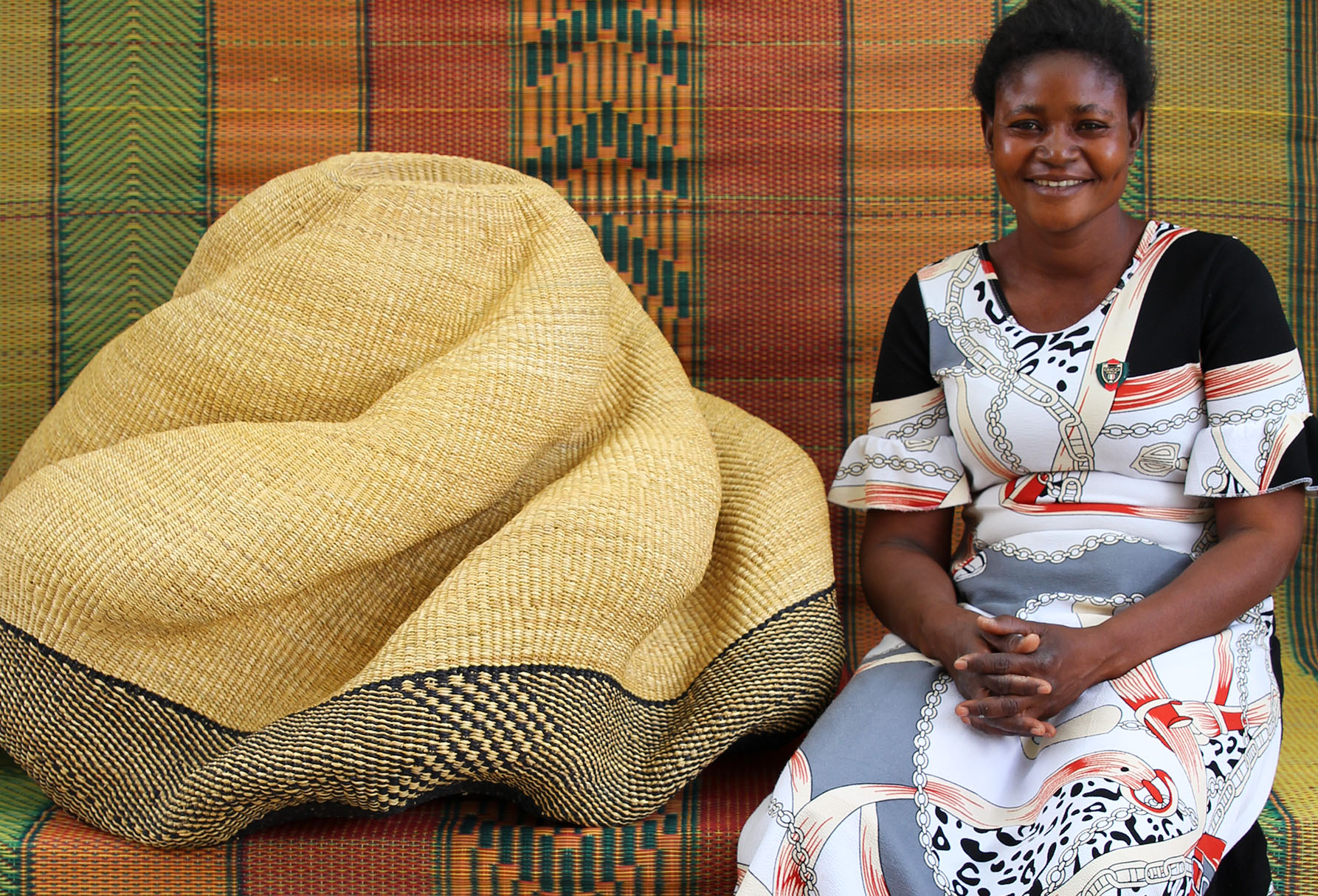
Celina Nmabila Apasinore.
Ghana
Bolgatanga, one of the most remote towns in Ghana, was the location chosen to develop the PET Lamp 2019, 2022 (PET Lamp Bolgatanga Large and Small) and 2023 (PET Lamp Gurunsi) projects.
In the heart of the Upper East Region and just a few kilometres from Burkina Faso, Bolgatanga is known as the “city of baskets” and is also the capital of the Gurunsi people. The importance given to basket weaving in this territory is one of the main reasons why we decided to go to this remote corner of Africa to develop three collections. Traditional basket weaving is regarded not only as a tool for day to day life and a livelihood for these people, it also helps to provide greater social cohesion and embodies the values expressed in their culture. All this makes basketry the biggest industry in this region.
During the workshops, we were able to discover a country full of surprises, a rich weaving culture, traditional buildings and enjoyed a close and easy-going relationship with the weavers, from whom we learnt the secrets of a technique full of riches. The experience also allowed us to open a window to enable them to update their traditional basketry by integrating PET bottles, which are a real and ongoing problem in this zone of Ghana.
Product produced
















